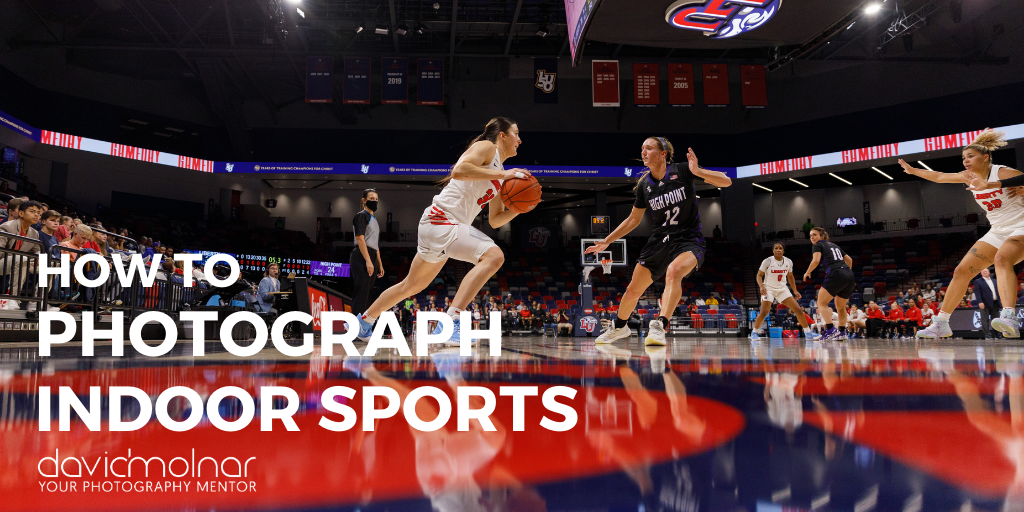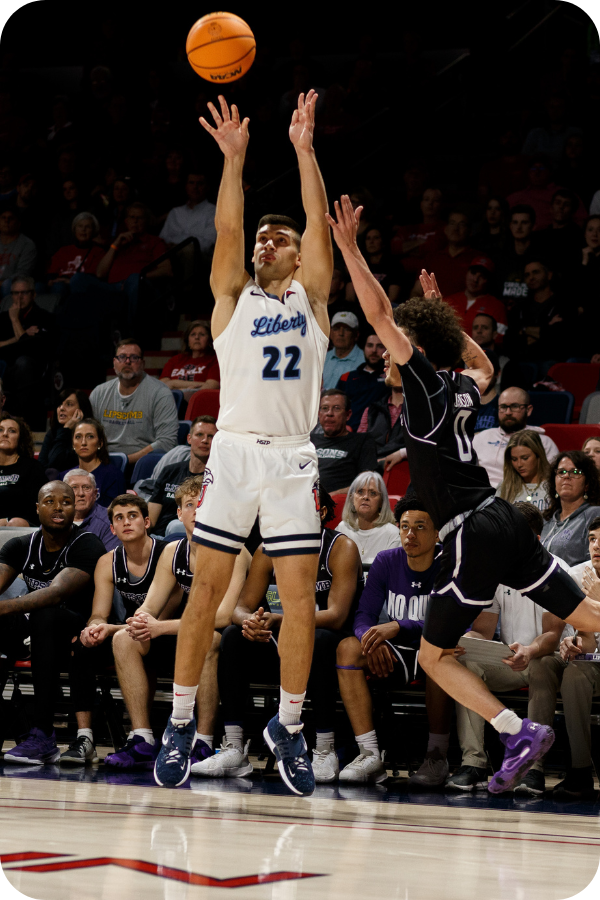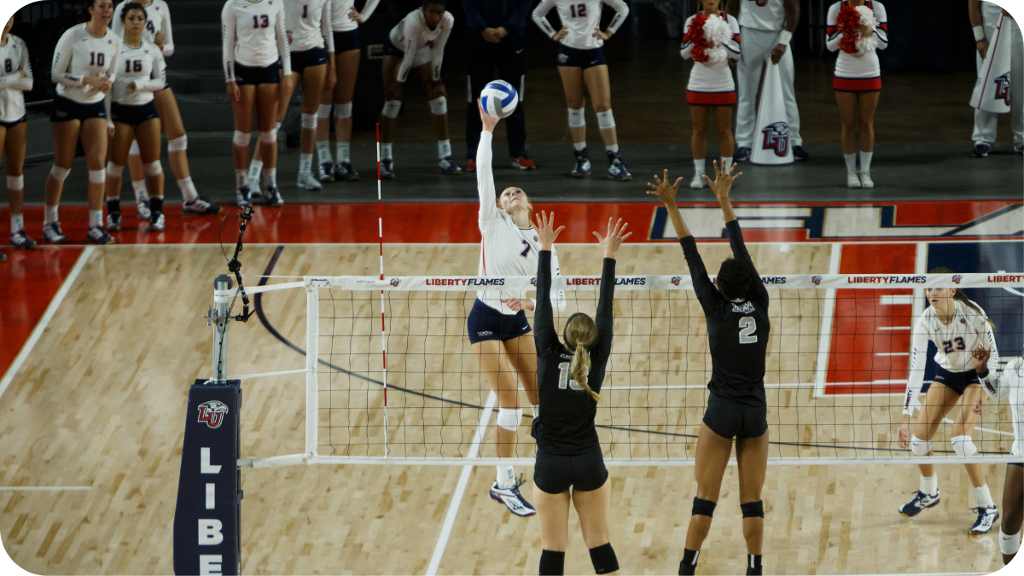- Total67
- Facebook14
- Pinterest15
- Email38

Photographing indoor sports can be a huge challenge. There’s all that fast action and energy you’re trying to capture and you’re severely limited on where you can position your camera. And while the court seems brightly lit, you quickly realize that it’s not when looking through the viewfinder of your camera.
To make matters worse, most places don’t allow photographers to use flashes. After all, blinding a player with a bright flash at a key moment in the game could unfairly change the outcome.
So how do you get crisp, well-lit images that capture the energy and excitement of indoor sports? You need to understand your camera and how to use its settings to adapt to the environment.
Read on for our top tips on how to photograph indoor sports!

Choosing the Right Gear
You’ll hear a lot that having the “best” camera gear is secondary to the skill of the photographer. And while that is definitely true, sometimes it really helps to have the right gear on hand.
Indoor sports photography is one of those instances.
Choosing a Camera
Because you’re trying to capture fast action in a “low-light” environment, you’ll get better results when you use a fast camera and a fast lens. Here are the specs you should aim for.
Read on for our recommendations!
- An interchangeable lens camera (DSLR or mirrorless is fine)
- Fast continuous shooting capability (8 frames per second minimum, but more than 10 is best)
- A deep buffer (for fast burst shooting)
- Fast autofocus (eye autofocus tracking is even better)
- Good low-light capabilities (no significant noise at high ISOs)
As you might imagine, the best cameras for shooting indoor sports don’t come cheap. However, there are serviceable models that won’t break the bank. They might not be the “best of the best” but you’ll still get some great images and have some fun!
Choosing a Lens
The next essential piece of equipment is a fast lens. Since you likely won’t be close to the action, make it a zoom lens. A 70-200mm is a good place to start, though you may consider eventually getting a fast super-telephoto lens.
One with a bigger maximum aperture will allow more light into the camera, so it is ideal for indoor sports photography. If you get into photographing indoor sports professionally, you’ll want a zoom lens with a maximum aperture of f/2.8.
Before you have a heart attack at the price, take a deep breath and know that you can start your journey using one with a fixed maximum aperture of f/4 and upgrade as needed.

Camera Settings for Indoor Sports
Without the lighting boost of a flash, you need to use your camera settings to compensate for the low lighting. Remember your good old friend, the exposure triangle? Let’s look at where each of the legs needs to be positioned to support your indoor sports images.
Shutter Speed
A fast shutter speed is critical for photographing indoor sports. Without it, your images will be too blurry. The players will never be posing for a picture as they dart around the court — and stationary players wouldn’t make an exciting sports image anyway.
So your camera has to be able to keep up and a fast shutter speed will freeze the action. Generally, you won’t want to go any slower than 1/500.
ISO
To help compensate, you can use your ISO to introduce more light into your photographs. Don’t be afraid to crank your ISO up to brighten your images.
If you have a camera body with good low-light capabilities, you can push the ISO quite high before there is considerable noise in the image. Plus, editing software can remove a fair bit of noise if needed when you edit the images afterward.
Experiment with what your camera can do (and what you can tolerate) until you find your sweet spot…. that is where the crisp magazine-worthy shots start to happen!

Aperture
Unfortunately, a fast shutter speed means your camera is letting in less light. You can help compensate for this by using a wide aperture. This will also help draw the viewer’s eye to the subject by isolating it against a blurry background.
However, depending on the distance between you and your subject, shooting at your camera’s widest aperture could make part of your subject blurry as well. At the very least, it means you have to nail your focus perfectly every time.
Use Continuous Focus
Speaking of which, how do you nail focus every time when your subjects are moving so quickly? Definitely put your camera in continuous focus mode.
This feature has different names depending on the camera model you choose. Canon calls it AI Servo while Nikon calls it AF-C. You may have to look this one up to find out what it is called on your camera.
Regardless, the point is that you want the continuous focus mode that tracks your subject. The opposite (which Canon calls One Shot) will lock focus on a single point and keep it there until you move it. That is helpful for stationary subjects, but definitely not in sports photography.

Back-Button Focus
Also, if you haven’t set up back-button focus yet, we recommend you give it a try. It’s a real game changer, especially for action photography.
Back-button focus means you assign the autofocus function to a button on the back of your camera instead of pressing the shutter halfway.
Consider this, you’ve focused on a player but another, closer one, suddenly steps in front of you. If you’re half-pressing the shutter, your focus goes wild trying to refocus on the closer player. Even as the impeding player moves out of the way, by the time you get your focus back — you’ve missed the shot.
If you are using back-button focus, all you have to do is lift your finger when the second player enters the frame. As they move out of the way, you’re still locked in on the original target and ready to take the image!

Composition Tips for Indoor Sports Photography
The technical stuff is only half the battle. When photographing indoor sports, your composition is just as important as camera settings. To capture the best shots of athletes in motion, you'll want to fill your frame with energy and action.
How do you do that?
You’ll generally be limited on where you can stand, but get as close to the field of play as possible. You want your subjects to fill up most or all of your frame. This will make it easier for viewers to connect with the emotion and intensity behind every shot.
Additionally, use leading lines such as goalposts or sidelines to bring focus towards a specific area within an image. This can also be used to create a sense of depth within any given photograph.
Don’t forget about basic compositional rules like the rule of thirds. Dividing up your frame into equal thirds can help add balance and symmetry while creating more interesting photographs overall!
And finally, don’t forget to turn your back on the action every once in a while. The story of the game doesn’t just happen on the court, sometimes it’s happening on the sidelines.
Capture the other players’ faces as they watch their teammates, showcase the coach biting his fingernails or beaming proudly, and even reactions in the crowd add interesting details to your story. The band, the cheerleaders, and the traditions — all come together to support that epic image of the game-winning point!

Editing Indoor Sports Photos
Editing indoor sports photos can be an important part of the creative process as it allows photographers to make subtle adjustments that will enhance their images. To achieve the best results, start by adjusting the white balance and exposure settings in order to bring out the most accurate colors and details within a photograph.
This is especially important when shooting under artificial lighting that may add unwanted hues to the image. Tweak the white balance to help bring back the vibrance and clarity if needed. It’s also important to choose the right white balance setting on your camera when shooting.

These are all things you want to be thinking about when shooting as well but you may not nail them perfectly during the fast action. You can take your time making small adjustments at your computer afterward.
Whether you're taking indoor sports photos professionally or as a hobby, having the right tools and techniques can make or break the shot. Having the best gear will make your job tremendously easier, but isn’t essential.
Now, get out there and have some fun!
- Total67
- Facebook14
- Pinterest15
- Email38





